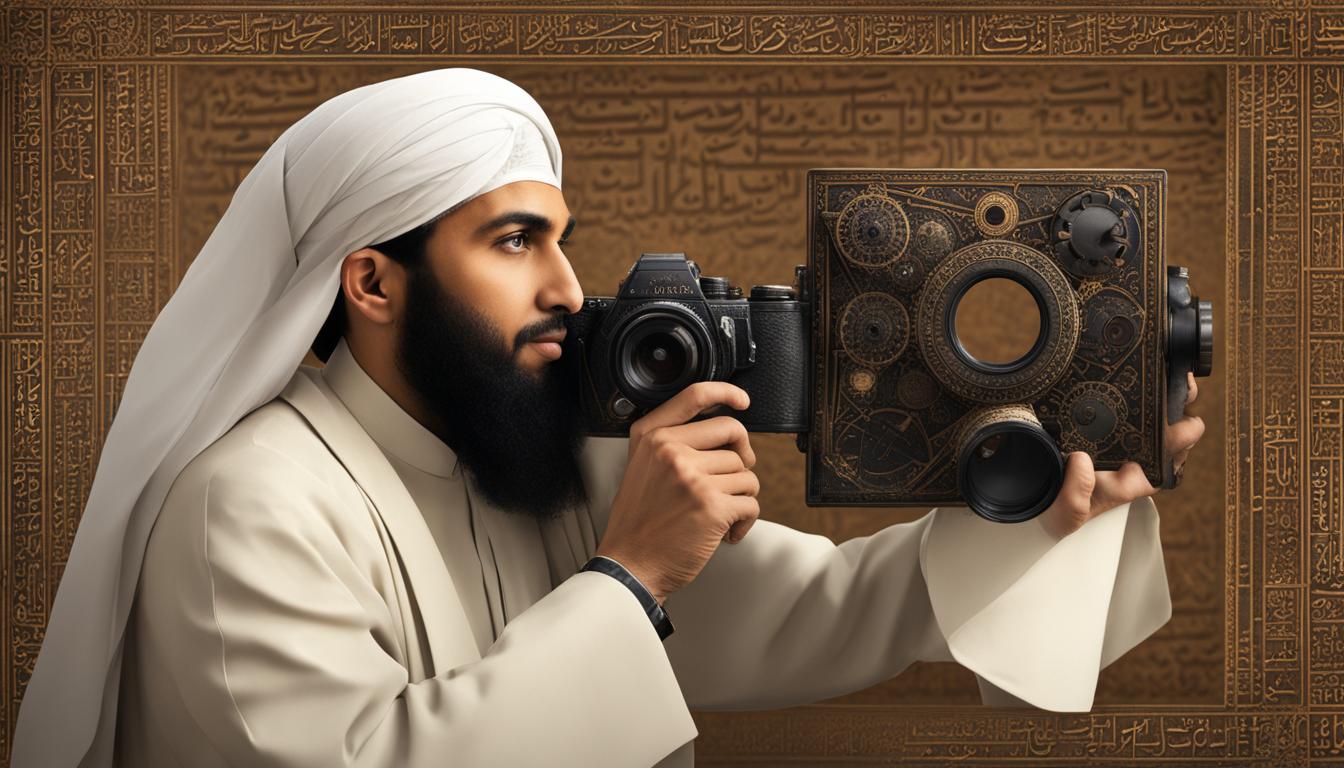Have you ever wondered who invented the camera? While the answer may not be widely known, there is evidence to suggest that a Muslim scientist, Alhazen, made significant contributions to the development of early camera technology.
Alhazen, also known as Abu Ali al-Hasan ibn al-Hasan ibn al-Haytham, was a 10th-century mathematician, engineer, and scholar from Basra, Iraq. He wrote a comprehensive book on optics, which included groundbreaking theories on the nature of light and vision. Alhazen’s work likely influenced the development of camera technology in later centuries.
Key Takeaways:
- There is evidence to suggest that a Muslim scientist, Alhazen, made significant contributions to the development of early camera technology.
- Alhazen’s book on optics laid the foundation for the understanding of light and vision, which likely influenced the development of camera technology.
- The invention of the camera was a collaborative effort involving inventors from various cultures and backgrounds.
- Muslim inventors, such as Alhazen and Ibn al-Haytham, played a significant role in the early development of photography.
- The camera as we know it today is the result of centuries of advancements and innovations by inventors from around the world.
The Contributions of Alhazen to Optics and Camera Technology
Alhazen, also known as Abu Ali al-Hasan ibn al-Hasan ibn al-Haytham, was a 10th-century Muslim mathematician, engineer, and scholar from Basra, Iraq. His most significant contribution to the field of optics was his book, “Kitab al-Manazir” or “The Book of Optics.” In this groundbreaking work, Alhazen developed a comprehensive theory of vision, challenging prevailing beliefs and providing a new understanding of how light interacts with objects and enters the eye.
In “The Book of Optics,” Alhazen rejected the commonly held view that vision was caused by rays emitted from the eye itself. Instead, he proposed that light reflects off objects and enters the eye, forming an image on the retina. His theories on optics and vision laid the foundation for the development of camera technology in later centuries.
One of the concepts described by Alhazen in his book was the camera obscura phenomenon. He explained how images are formed when light passes through a small hole into a darkened room or enclosure, projecting an inverted and upside-down image on a surface. Alhazen’s understanding of this phenomenon provided valuable insights into the properties of light that would eventually shape the design and functionality of cameras.
Alhazen’s Book of Optics
Alhazen’s book, “The Book of Optics,” represented a significant leap forward in our understanding of light, vision, and the principles that underpin camera technology. His theories and explanations not only challenged long-held beliefs but also provided a solid foundation for future advancements in the field of optics. Alhazen’s contributions to camera technology extended beyond his time, influencing the work of later scientists and inventors who built upon his insights.
The image formed by a camera obscura, with its inverted and upside-down nature, was a key concept explored by Alhazen. This understanding of how light behaves when passing through a small aperture would prove fundamental to the creation of cameras. Alhazen’s work on optics and camera technology paved the way for the continued development and refinement of cameras throughout history, ultimately leading to the sophisticated devices we use today.
Alhazen’s legacy as a Muslim innovator in the field of optics and camera technology cannot be overstated. His book, “The Book of Optics,” revolutionized our understanding of vision and light, providing the necessary groundwork for the development of cameras. By challenging prevailing beliefs and introducing new theories, Alhazen laid the foundation for future advancements that would shape the course of camera technology. Today, we continue to benefit from the contributions of Alhazen and other Muslim inventors who paved the way for the cameras we rely on for capturing, preserving, and sharing our valuable memories.
Early Muslim Innovations in Photography
While Alhazen’s work laid the groundwork for camera technology, it is important to note that the invention of the camera was a collaborative effort involving inventors from different cultures and backgrounds. Among them, several Muslim inventors made significant contributions to the early development of photography.
One such pioneer was Ibn al-Haytham, who lived in the 11th century. His work on optics and light provided a basis for future advancements in the field. Ibn al-Haytham’s experiments and innovations in camera technology helped refine the understanding of how light interacts with objects and paved the way for the creation of more sophisticated image capturing devices.
These Muslim inventors were instrumental in pushing the boundaries of camera technology, exploring the properties of light, and developing innovative methods for capturing and preserving images. Their contributions ensured that the field of photography continued to evolve and progress over time.
The Legacy Continues
The legacy of these Muslim innovators in camera technology lives on today. Their groundbreaking discoveries and inventions laid the foundation for the modern camera and continue to shape the way we capture and preserve images. Their understanding of optics and light not only enhanced the field of photography but also had a profound impact on various other scientific disciplines.
It is important to recognize and celebrate the diverse origins of camera technology. By acknowledging the contributions of Muslim inventors and pioneers, we honor the multicultural nature of innovation and inspire future generations to pursue their passions in the field of science and technology.
Timeline of Islamic Contributions to Camera Development

Conclusion
The invention of the camera is a fascinating journey that spans across cultures and centuries. While Muslim inventors have made notable contributions to the development of camera technology, it is important to acknowledge the collective efforts of inventors from various backgrounds.
The camera’s history is a tapestry of innovation and ingenuity, with Muslim inventors playing a significant role in its early development. Scholars like Alhazen and Ibn al-Haytham paved the way for our understanding of optics and light, laying the foundation for future advancements in camera technology.
However, it is crucial to recognize that the evolution of the camera involved collaboration and exchange between different civilizations. From Chinese inventions to Greek discoveries and European Renaissance breakthroughs, the camera as we know it today is the culmination of diverse contributions.
In conclusion, the invention of the camera is a testament to human creativity and curiosity. While early Muslim inventors made important strides in camera technology, the camera’s journey is a testament to the collective efforts of inventors from various cultures and backgrounds.
FAQ
Who is considered the true inventor of the camera?
The true inventor of the camera is not widely known, but there is evidence to suggest that a Muslim scientist, Alhazen, made significant contributions to the development of early camera technology.
What book did Alhazen write that contributed to the development of camera technology?
Alhazen wrote a comprehensive book on optics called “Kitab al-Manazir” or “The Book of Optics.” This book laid the foundation for understanding how light interacts with objects and how images can be formed.
What is the camera obscura?
The camera obscura is a phenomenon described by Alhazen that explains how images are formed upside-down and inverted due to the properties of light.
Did Alhazen work alone in developing camera technology?
No, the invention of the camera was a collaborative effort involving many inventors from different cultures and backgrounds. Alhazen’s work was just one contribution to the development of camera technology.
Were there other Muslim inventors who contributed to early camera development?
Yes, there were several Muslim inventors who made significant contributions to the early development of photography, including Ibn al-Haytham, who lived in the 11th century.
How long did the timeline of Islamic contributions to camera development span?
The timeline of Islamic contributions to camera development spans several centuries, from the 10th century with Alhazen’s work on optics to the following centuries with continued contributions from Muslim scientists and inventors.
What were the contributions of Muslim inventors to camera technology?
Muslim inventors, such as Alhazen and Ibn al-Haytham, demonstrated the potential of optics and light in capturing and preserving images. Their innovations paved the way for the development of photography as we know it today.
Who else contributed to the invention of the camera?
The invention of the camera was a result of contributions from various cultures and civilizations, including the Chinese, Greeks, and Renaissance Europeans. The camera as we know it today is the result of centuries of advancements and innovations.
What is the legacy of Muslim innovators in camera technology?
Muslim innovators in camera technology played a significant role in the early development of photography. Their contributions should be acknowledged and celebrated for setting the stage for future advancements in the field.

